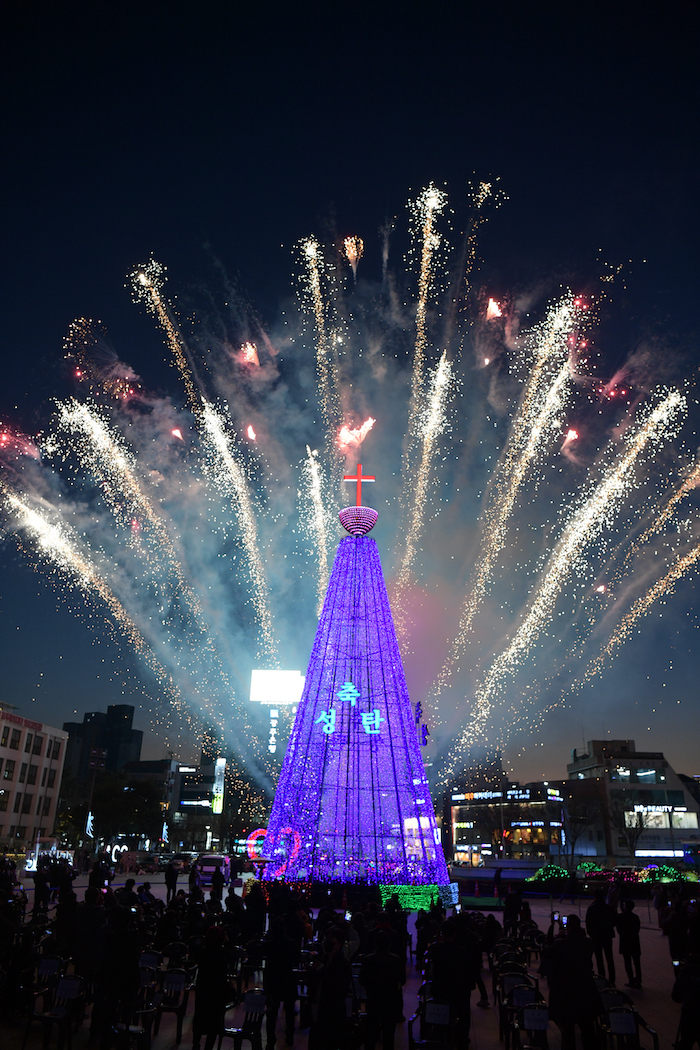Christmas Across the Globe – And Other Holidays Too!
Christmas is observed around the world and not only by Christians – not always on December 25 and not always with the same customs. Not all cultures observe Christmas, of course, but so many have some type of holiday celebration in December. Because of this worldwide holiday season, the Gwangju News has invited Gwangju residents to share with us how the holiday season is observed in their home countries. Join us in this journey across the globe, with country stop-offs from west to east. — Ed.
–
Lindsay Herron is from Albuquerque, New Mexico, in the American Southwest. She has been teaching at Gwangju National University of Education since 2008.
It’s Christmas Eve in New Mexico; step outside with me and take a deep breath of the crisp, dry air. Over the typical tang of juniper trees and the sultry scent of piñon-scented smoke from fireplaces, you might detect the tantalizing aromas of posole (pork and hominy stew), tamales (dough made from masa and steamed in a corn husk), and carne adovada (red chile pork stew), as well as the comforting cinnamon-and-anise scent of biscochitos (traditional New Mexican cookies). The neighborhood around us gleams silver in the light of the moon – there’s not a cloud in the sky – and while a few houses have their holiday lights turned on, the real stars of the show are the warm, glowing lights of luminarias, open paper bags with a few centimeters of sand filling their bottom, illuminated from the inside by a small candle nestled safely in the sand.
We’ve just returned home from some of the city’s Christmas Eve highlights: wandering through Old Town, where hundreds of luminarias adorn the stores, walls, and walkways; cheering for a handful of hot air balloons tethered tightly to the ground at a local park, cheekily greeting passers-by with a roar of their flames; and silently contemplating the breathtaking beauty of a local cemetery, where countless luminarias reverently placed on graves by loved ones dot the darkness, nearly uncontaminated by other light sources. Tomorrow, we’ll exclaim over our stockings and enjoy a boisterous breakfast as a family; we’ll laugh and unwrap the gifts under the tree; and we’ll close the day with a traditional turkey dinner. Tonight, though… Tonight is about peace and serenity, gratitude and affection, contemplation and connection. ¡Feliz Navidad!
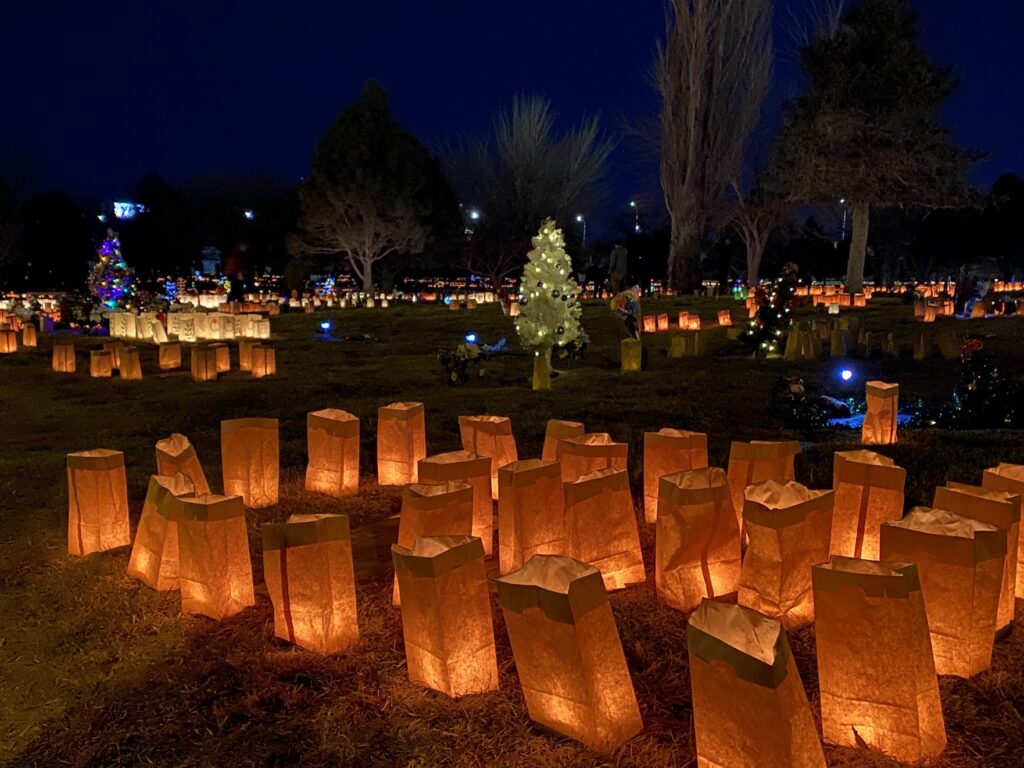
Luminarias on graves at Mt. Calvary Cemetery, Albuquerque.
–
Caleb Sekeres is from Providence, Rhode Island, in the northeastern United States. He is the co-owner of the bar Nirvana, near the Asia Culture Center, and has lived in Gwangju for fourteen years.
I was raised in a conservative Jewish household in Rhode Island, which is approximately one percent Jewish overall. My grandparents came to U.S. from Eastern Europe when they were children, and they were, like most immigrants, poor. My parents moved to Rhode Island from New York City in order to raise a family with a better quality of life. My early memory of the eight nights of Hanukkah (Chanukah), our end-of-year holiday, is of receiving few presents. We always lit the menorah (a candelabra with eight lower candles and one higher one) and said a prayer during Hanukkah. As my parents worked their way up the economic ladder, my brother and I received more and better presents during Hanukkah. It became more celebratory!
On Hanukkah, we celebrate the rededication of the Second Temple in Jerusalem in the second century B.C.E., a celebration of a victory over oppression. According to the Talmud, one of Judaism’s most central texts, Judah Maccabee and the other Jews who took part in the rededication of the Second Temple after defeating their religious oppressors, witnessed what they believed to be a miracle. Even though there was only enough untainted olive oil to keep the menorah’s candles burning for a single day, the flames continued flickering for eight nights. This wondrous event inspired the Jewish sages to proclaim a yearly eight-day festival. Hanukkah was born.
For me and my family, and for my Jewish friends, Hanukkah was not a major religious holiday, rather an important social one, when special food (latkes – potato pancakes) was eaten, traditional games (dreidel – a sort of top) were played, and gelt (money and gifts) was given. Even in Gwangju, where I have no temple to pray in, my sons and I wear yarmulkes (religious head coverings), light the menorah, say a prayer, and give gifts. It is one of the few Jewish traditions I am proud to say I keep alive for my Korean-American sons.
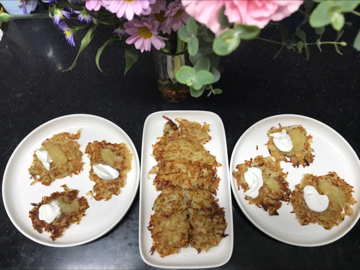
Potato latkes – a Hanukkah tradition.
–
Íde O’Connell is an English teacher from Ireland. She recently moved to Gwangju from Hong Kong but has previously lived in Seoul for many years.
In Ireland, as in many countries, we decorate Christmas trees, exchange gifts, sing carols, and of course, eat a delicious meal, usually roast turkey on Christmas Day itself. However, as Ireland has traditionally been a Catholic country, some of our Christmas customs are based on that, such as putting up a crib, attending midnight mass on Christmas Eve, and leaving a candle in the window at night to symbolize lighting the way for Mary and Joseph.
One tradition unique to Ireland is “Nollaig na mBan” on January 6 which means “Women’s Christmas” or also called “Little Christmas.” This is supposed to be the day when men take over the housework and women get to relax after all their hard work over Christmas. This custom had almost died out but thankfully is enjoying a resurgence!
But perhaps the most unusual tradition is the Wren Boys Procession, which stems from ancient times when young men would hunt a wren and parade colorfully and loudly through the streets with it on St. Stephen’s Day (December 26). The custom is so old nobody can agree on how it started, but even today, the wren boys still wear straw costumes and sing traditional songs. But they use a fake wren and raise money for charity.
As this Christmas will be my first with my in-laws in Gwangju, it will be a chance to introduce some Irish traditions to them!
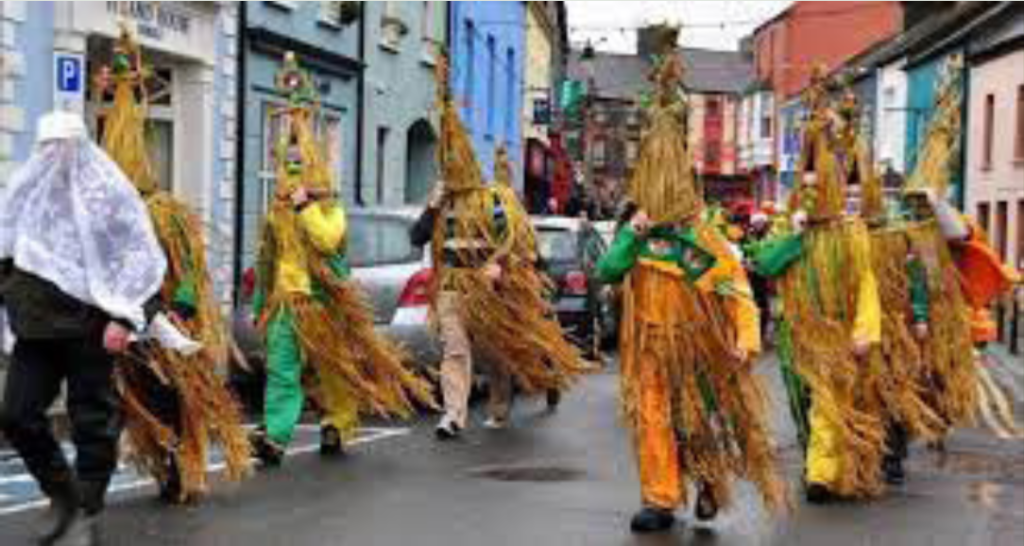
The Wren Procession.
–
Julien Laheurte is a literary translator from France who has been residing in South Korea for the past two years.
In France, Christmas is called Noël. Celebrations kick-off with the Marché de Noël (Christmas Market). The Christmas Market season typically begins around the end of November, reaching its peak a few days before Christmas Eve. Markets located in the north and northeastern regions of the country, in cities like Strasbourg (near the German border), Metz, Amiens, and Lille are often regarded as the best ones. A typical market consists of multiple small wooden stalls arranged around the main square of the city. There, visitors can discover traditional winter delights, such as vin chaud à la cannelle (hot wine with cinnamon); tartiflette, a gratin composed of potatoes, reblochon cheese, lardons, and onions; and bretzel (pretzels). It is commonly believed that the Marché de Noël is the last chance to consider if you’re on a diet.
Noël takes place on December 24 and 25. On the evening of the 24th, close relatives come together to partake in a lavish meal. On the menu are oysters, snails, foie gras, and smoked salmon. For dessert, the traditional Yule log is a must. As the clock strikes midnight, with everyone satiated and perhaps slightly drunk, we hug each other and shout “Joyeux noël!” (Happy Christmas!) while exchanging presents. Churches also organize midnight mass for those seeking a more traditional touch. The 25th is a national day off, allowing families to celebrate Christmas in their own unique way. In my family, we simply gather around the Christmas tree watching movies and relishing quality time together.
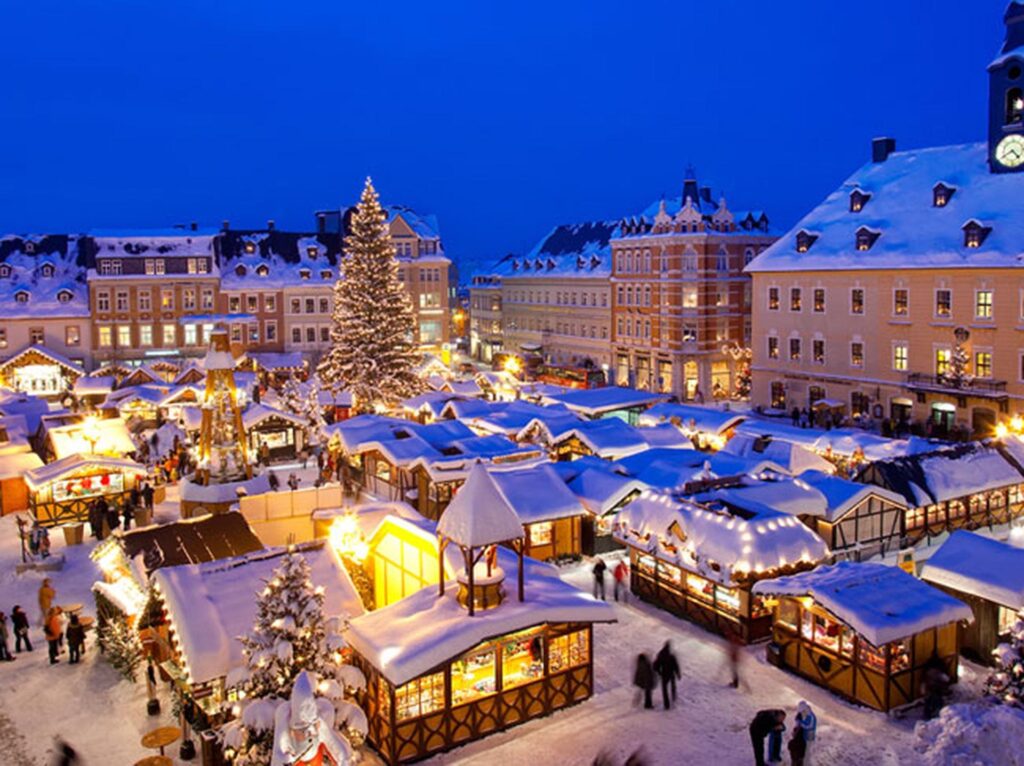
Christmas Market at Strasbourg, Alsace.
–
Jana Milosavljevic is from Serbia. She is a coordinator at Gwangju International Center and has lived in Korea for six years.
In Serbia, Christmas (called Božić) is thought to be the greatest and happiest of all holidays, celebrated in family circles and preserving numerous traditions. As the dominant religion in Serbia is Orthodox Christianity, we celebrate Christmas on January 7 (which is December 25 of the Julian Calendar).
Interestingly, in Serbia, what the world knows as the “Christmas” tree is decorated for the New Year’s celebration, and is not the centerpiece of Christmas. That role belongs to badnjak: a young oak tree covered in golden leaves. Traditionally, on January 6 (called Badnji dan), the men of the house would go to cut an oak tree to be turned into a badnjak before sunrise. Although in some rural areas this is still practiced, most city dwellers only buy a couple of small branches at the market or at church. These are brought into the home in the evening, followed by the greeting: “Srećno Badnje Veče!” (“Happy Christmas Eve!”).
On Christmas morning, the traditional Christmas bread (called česnica) is eaten and the family member who finds the coin baked into it will be the luckiest one in the following year. The first guest who steps into one’s house on Christmas is called položajnik, and it is believed that they predict what the whole year will be like for the family: if a good and kind person comes, the year will also be such. Christmas is celebrated with the greeting “Hristos se rodi!” (“Christ was born!”), to which “Vaistinu se rodi!” (“He really was born!”) is the reply.

Serbian Christmas badnyak branches.
–
Yousra Feriel Drioua is from Algeria. She’s a graduate student under the Global Korea Scholarship and has lived in Gwangju for a year.
In Algeria, we do not celebrate Christmas as we’re a Muslim country; however, a popular official winter holiday is Yennayer, known as the Amazigh New Year! It is celebrated every January 12th according to the Julian calendar, and next January will mark its 2974th year. The word Yennayer is thought to be a combination of the words yenn (one) and ayur (month) in Amazigh. The holiday dates back to antiquity, is rooted in North African folktale, and is celebrated across the Maghreb region. It is a festival of nature, agrarian life, and generosity. It’s about creating harmony with nature, and it represents the bond between the Berber people and their land.
Yennayer customs differ from one area to another. Most families would opt for couscous (steamed semolina served with various broths/sauces) as their main dish. Back in my family home in Oran, however, we enjoyed rustic and country-style meals such as cherchem, which is a soup made up of boiled chickpeas, red fava beans, and wheat, in addition to everyone’s favorite dry fruits and assorted nuts, chocolates, and seasonal fruits. The family usually dresses up in traditional clothes, have cherchem for dinner together, and then sit in a circle on the ground to break the nuts out of their shells. As a kid, all I cared about was getting the biggest portion of dry nuts and sweets, but as I grew older, I grew to appreciate those simple flavors and ponder on how they were brought to my plate. In a way, being grateful towards one’s land and what it brings forth, and being with one’s family is the core of this celebration.
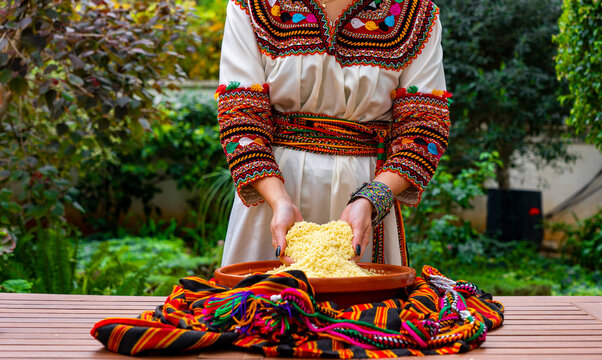
Woman in a traditional Amazigh outfit preparing couscous.
–
Elvis Muhunzu is from Kenya. He is a GIST graduate student, and he has been in Gwangju for the past six years.
In Kenya, Christmas isn’t just about a snowy landscape or Santa’s sleigh. It’s a bit like Chuseok or Seollal in Korea – a time when the whole nation gets into the spirit of the season. A whopping 80 percent of Kenyans are Christians, so when December rolls around, it’s time to party! Nairobi, the bustling capital, nearly turns into a ghost town as buses and cars are loaded with people and presents, and are bound for the countryside to reunite with your far-flung family members.
Upon arrival, everyone eats, celebrates, and catches up on all the juicy gossip! Adults dote on the elderly and swap stories; the kids have a blast, playing with long-lost cousins and practicing drama skits and choir performances for church.
The culmination of this festive fervor is a religious celebration like no other. On Christmas Eve, everyone gathers for songs and dance. Come Christmas Day, churches hold services, and the birth of Jesus is reenacted with meticulous drama skits. Church usually wraps up around midday because the real feasting is just getting started.
Expect a sheep, goat, or even a cow to meet its culinary destiny. The celebrations continue well into the night, and if you happen to wander into a neighbor’s home, you’ll be treated to some delightful treats.
The party goes on until New Year’s Eve, where staying up all night is the norm. Oh, and don’t forget, December 26 is a holiday too – Boxing Day! It’s a merry, magical, and memorable time that Kenyans cherish, bringing family and friends together in the true spirit of Christmas.
Thalita Shongwe is from South Africa. She is an English teacher at Dogok Middle School and has lived in Gwangju for one year.
Christmas in South Africa is not a Christmas one sees on TV when you watch a heart-warming Christmas movie. Christmas caroling, drinking hot chocolate, and building snowmen – South Africans do none of these because at Christmastime, South Africa is at the peak of its summer season. Instead, we’re eating ice cream and trying to cool ourselves down with a swim in the pool.
After slaving away all night in the kitchen on Christmas Eve making a great quantity of my mom’s famous chakalaka, my family wakes up early in the morning to attend a short church service, then we drive to my grandmother’s house. After getting smothered with kisses from my grandmother, aunts, and uncles, it’s time for the main event: Christmas lunch. Food is the highlight of Christmas in my family. People dish up for themselves buffet style, and we sit outside – the adults on chairs and the children on mats – under the big tree in the front yard, eating and chatting, as ’80s and ’90s R&B hits play in the background.
When we have all had dessert, we bring out the board games. In the late evening, everybody gets ready to leave, washing dishes and taking some leftovers with them. We say our goodbyes with a “see you tomorrow” because the following day is also a holiday!
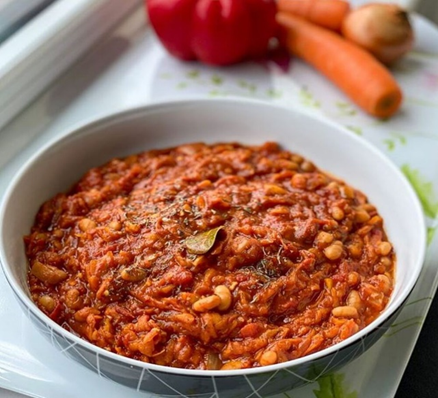
Chakalaka, a South African side dish made with carrots, beans, onions, and chilli peppers. (TheFeedFeed)
–
Neha Bisht from India. She is a PhD student at Chonnam National University and has lived in Gwangju for one and a half years.
India is predominantly a Hindu country and known for its cultural and religious diversity. While Christmas is a Christian festival, it has widespread appeal in India, transcending religious boundaries. In India, Christmas is a public holiday. The Christmas celebration includes religious ceremonies, traditional midnight mass, carol singing, and decoration of churches with lights and flowers. Shopping malls, marketplaces, hotels, education institutes, and various organizations are often elaborately decorated. In metropolitan cities, public gatherings, cultural programs, plays, concerts, and fun events are organized.
At Christmastime, my family and I used to decorate the home with lights, balloons, and a Christmas tree. Family and friends would organize a small party at home, where everyone wore a Santa cap and one person become Santa Claus to distribute the children’s gifts. The small party ended with good music, dance, and delicious food. Two years ago, my last Christmas in my home country, I spent Christmas Eve with my work colleagues. We put up decorations, ate delicious foods, played games, and exchanged gifts. Then on Christmas Day, I went to church with my friends and later went shopping for Christmas gifts.
Since I moved to Gwangju, I want to make the upcoming Christmas festival memorable. I am thinking of decorating my room and making a Christmas tree. Then in the evening, I will go out with friends to a marketplace where a Christmas celebration is to take place. Later, we will cook together and enjoy the food with good Bollywood music and dancing. I hope this Christmas will bring much prosperity and happiness to everyone’s life.
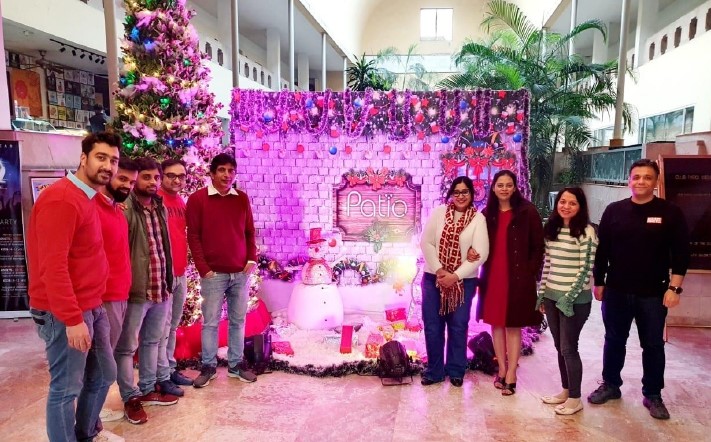
Neha with colleagues at Christmastime in India.
–
Qurratu is from Sarawak, Malaysia. She is a university student at Chonnam National University and this is her ninth month in Gwangju, South Korea.
Malaysia is one of the countries with the most public holidays, around 23 to 25 days in a year. Malaysia is multi-religious and multicultural, so all celebrations are taken into account. You guessed right! Christmas is also one of them! As a Muslim, I do not celebrate Christmas, but it doesn’t mean I don’t do anything on December 25. How do I, and probably most Muslims in Malaysia, spend this public holiday?
Firstly, we can play tourist at home in the Sematan area or go on a short getaway to Sabah spending our leisure time with family and friends. Next, there are open houses happening everywhere in all 14 states. Malaysians love to invite others to their home and eat delicious foods together, chat a lot, and play board games. Lastly, December 25 is a shopping and eating out time. My childhood was full of malls and restaurants during this time. Thanks to the year-end sales, my brother and I got to buy things like toys and comics that we wanted at half price. Also, it is a holiday, so no housework!
Above all, although we Malaysians have different religious practices and cultural backgrounds, it does not stop us from spending this public holiday together. We respect each other’s beliefs and know our boundaries to ensure our well-being. Thus, to all who celebrate Christmas, “Merry Christmas!”
–
Karina Prananto is from Jakarta, Indonesia, and she has been living in Gwangju since 2006.
Although Protestants and Catholic make up only about 10 percent of the 277 million population, they are the second and third largest official religions in Indonesia, so Christmas, or Natal in Indonesian, is a big holiday. If you live in regions where most of the population is Christian, which is mostly in the eastern part of the archipelago, Christmas preparation may start weeks before. There will be parades and festivals rooted in local culture and customs. Meanwhile in big cities, the Christmas atmosphere usually comes to shopping centers (where most urban Indonesians spend their free time) with huge Christmas trees and decorations.
Families usually spend their Christmas morning at church and then have lunch with the extended family. School holidays are for about two weeks until New Year’s, so people use this time to go back to their hometowns or travel. My sister and I used to decorate our Christmas tree together; then we went to my parents’ hometown in Central Java and met all our relatives. We rented a villa in the highlands and stayed there for two days or so, while traveling to surrounding areas, sometimes to volcanoes (yes, Indonesians hike up volcanoes for leisure!). My last Christmas back home was on 2008, so I haven’t celebrated Christmas with my family for a very long time. Here, my Christmas is very simple, but I try to recreate the tradition by letting our sons decorate our Christmas tree. Then we will go to church services in our neighborhood. But still, my wish is to be able to spend Christmas again back home.

Papua. (TNI Angkatan Darat)
–
Lee Mikyoung is from Yeosu (in Jeollanam-do, Korea) and has lived in Gwangju for six years. She also has lived in Germany, Canada, and the USA, experiencing different Christmas atmospheres. She is an assistant professor at Kwangju Women’s University, Gwangju.
In Korea, Christmas holds profound significance, especially within the Christian community. The celebration is characterized by a strong focus on attending church services and participating in meaningful religious activities. Families unite to honor the birth of Jesus Christ through special services featuring hymns and sermons, accompanied by shared joy during meals and gift exchanges.
While growing up in a Christian family, Christmas always held a special place in my heart. In our small countryside church, I was led to assume various Christmas roles each year: student moderator, musician, pianist, and group singer. Surprisingly, the month-long rehearsal period with teachers and friends every evening turned out to be more enjoyable than the actual Christmas Eve performance!
Apart from family traditions, one particular custom involves couples sharing romantic moments, akin to Valentine’s Day, as Christmas is considered a day for couples to celebrate their love. However, the religious aspect remains crucial, with many attending special church services. Many churches organize events such as musicals, plays, and cantatas, fostering community spirit and celebrating faith.
In essence, Christmas in Korea blends religious devotion, cultural practices, and family values. It serves as a reminder of Jesus Christ’s teachings and promotes love, compassion, and unity within the community. As Christmas approaches, my plans include preparing Christmas Eve events with junior high school students at church and enjoying festive meals with my husband, immersing ourselves in this unique holiday atmosphere.
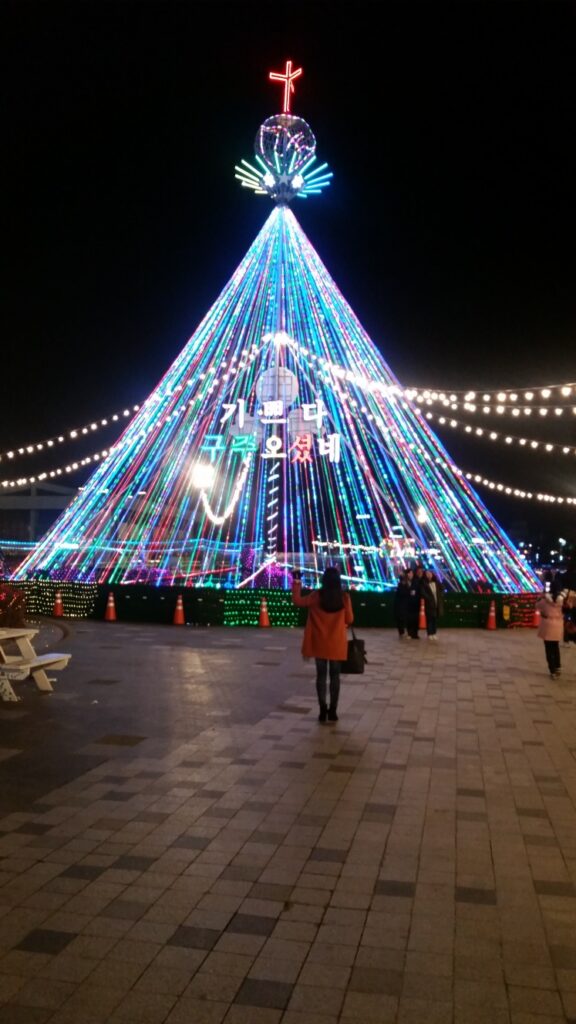
Christmas tree at the Asia Culture Center in downtown Gwangju.
–
Kim Sunhong (Sunny) is a native of Gwangju. He is the owner and operator of the 1st Recipe, a pasta and pizza restaurant in downtown Gwangju.
The end of 2023 is approaching. For most Koreans, Christmas is celebrated as a holiday to end the year regardless of religion. Restaurants are one of the places that people especially frequent during the holiday season. As soon as Halloween is over, the Christmas decorations start going up at the 1st Recipe: the two-meter Christmas tree with its accompanying train set, Santa Claus, reindeer, figurines, candles, lanterns, holly, pine cones… Along with the sparkling decorations and the complementing Christmas music, the carefully prepared dishes allow those who visit the restaurant to feel the special warmth of Christmas regardless of how cold it may be outside. At the end of the year, you can make happy and special memories in a space full of the Christmas spirit and holiday warmth.
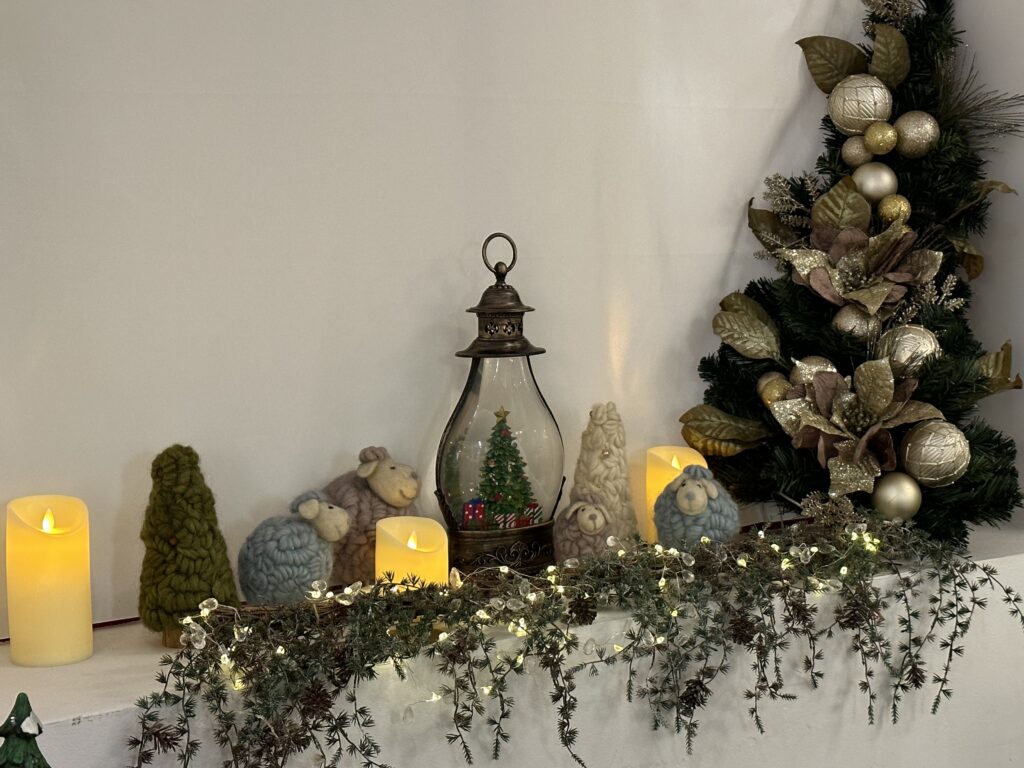
Christmas decorations at the First Recipe.
Compiled by David Shaffer.
All photographs courtesy of the author unless otherwise credited.





